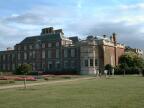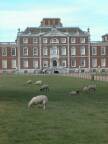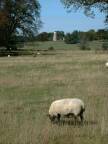



Wimpole Hall (or Wimple Hall) is a big pile southwest of Cambridge, owned by the National Trust.
Like all National Trust buildings, you can't photograph inside -- but this doesn't much matter, as the most notable feature of the building, a stunning drawing room opened up by John Soane in the 1790s, is probably unphotographable unless you have a view camera with an exceptionally wide lens. (What is irritating is that you can't even enter this drawing room but can only view it from the edges.)
Soane opened up this room at the request of the Philip Yorke, who had just taken over Wimpole Hall on becoming the third Earl of Hardwick. Normally I have little appetite for the reverent talk of the aristocratic past that permeates National Trust guidebooks and so forth, but Yorke deserves comment. He was no rich twit (unlike the fifth Earl), but instead a man with many interests who had happened to meet Soane years previously when both were engaged in study tours of antiquities in Italy. This meeting turned into a friendship and one of Soane's happier professional relationships.
Soane was also responsible for extending an earlier library room -- though not the one used by an earlier owner, Edward, Lord Harley, for what came to be called the "Harleian" collection -- as well as a bath (which I unaccountably forgot to look for) and the home farm (see below).
So it's a very big pile indeed. What you see here is mainly its refaced design by Henry Flitcroft in the 1740s.
Beyond the haha are sheep.
Next to the building is a small church (not National Trust). This has a chapel with monuments to members of the families who have owned Wimpole Hall. Here are two of those monuments:
On the left, Sir Thomas Chicheley (d. 1616), father of the Sir Thomas who built the large house.
On the right, that of the second Earl of Hardwicke (1740-90), bibliophile -- important in the British Museum's acquisition of the Harleian manuscripts -- and Robert Walpole nut. (Care to read what it says? Here you go.)
 Every self-respecting owner of a stately pile has a view of some ruin.
Wimpole Hall is no exception; here is the ruin as seen from near the
Hall.
Every self-respecting owner of a stately pile has a view of some ruin.
Wimpole Hall is no exception; here is the ruin as seen from near the
Hall.
If the vandalism of history doesn't conveniently provide a ruin, he has it built himself. This one was designed by Sanderson Miller in 1751 (making it an early example of such gothicism) and probably built, to slightly altered design, in 1772. These fakes ("follies") are usually closer than you at first realize, and small. Wimpole's example isn't; it's an energetic walk away from the main building -- grid reference circa TL 330 510 -- and has curtain walls sixty metres long.
I'm not a horsy person at all. But if I had horses, I'd like them stabled in a place like this, designed by H E Kendall and built in 1852:
You can rent a marquee here for some social occasion. Mostly for weddings, I suppose.
Wimpole Hall's other major attraction is its home farm, again built in the seventeen nineties at the third Earl's request and according to the designs of John Soane (who had not previously designed anything like it). It's an excellent example of the enthusiasm for agricultural efficiency and reform that absorbed many members of the aristocracy of the time. (George III's interest is dramatized in The Madness of King George.) Here are bred now rare varieties of goats, pigs, etc., some of which would have been raised on the farm when it was new. But even the tractors are remarkable -- note the lack of tyres on the one on the right.
To me, a cow is a cow is a cow. But longhorn cows are a bit rare outside westerns. These horns are much less symmetrical than anything I remember seeing in a western, but that's Hollywood homogenization for you.
It was awfully difficult to take a mug shot of any of the various handsome goats.
This great barn is one of John Soane's larger buildings. Here you see the courtyard, the roof (with martens about to fly south for the winter), and just inside the entrance.
The kids can enjoy themselves too. Boys can ride big powerful machines and crash into each other. Old boys such as myself content ourselves with feeding the goats.
There's a sheep race, too. This time around, the contestants were Too Fast for Ewe, Fleeting Fleece, Lamb Chop, Rare Racer, and Wooly Jumper.
Cows, goats, sheep . . . all very well, but I'm enough of an Englishman to be more interested in pigs. The ones with big spots are Gloucester Old Spot, and the reddish ones are Tamworths.
All very peaceful. But that was before feeding time (4 p.m.). At feeding time, the pigs become very excited and vocal. (Next time, I'll have to take a camera that records sounds, too.)
In the courtyard, this lady was selling hats, gloves, etc., she made of thread spun from the wool of Wimpole Hall's sheep. I bought a hat of undyed, naturally deep brown wool for a friend.
Most of the information on this page is pillaged, I hope accurately, from
For more on Wimpole Hall, see the official site, wimpole.org.
Any comments? Corrections? Bouquets? Write to me (Peter Evans).
Tentatively sellotaped together 22 October 2000; first uploaded 4 February 2001; last non-trivially fiddled with, 12 February 2001 -- except that, after I'd received at least one polite nudge, I changed "southeast of Cambridge" to "southwest of Cambridge" on 3 January 2014.